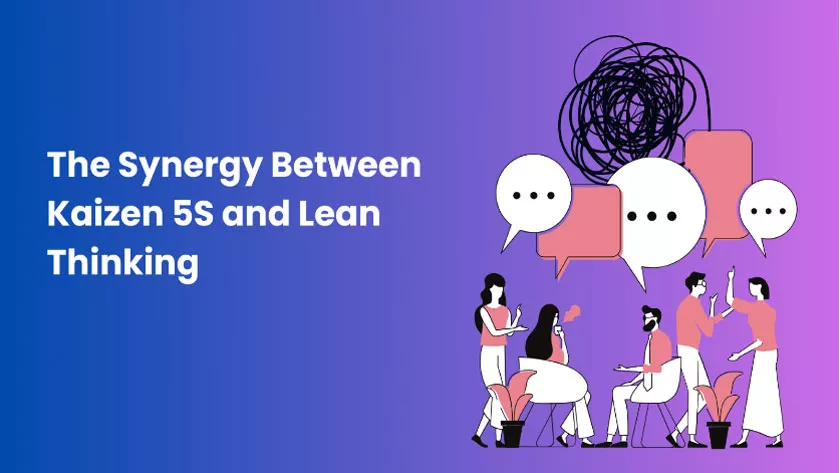
The main goal of Kaizen 5S is to apply Some principles to create a workspace that is efficient and well-organized. It may appear simple on the surface, but the influence it may have on an organization’s operations is substantial.
And it is for this reason that organisations all over the world are constantly searching for ways to improve their operations, boost efficiency, and boost overall production, and one methodology that has risen to prominence in this search for perfection is Kaizen Training.
Kaizen 5S also investigates how they interact with Lean Thinking principles, another strong Approach in the field of operational excellence. So, let’s discuss how they work together to build a formidable trio that can change the way organisations run, innovate, and prosper.
Table of Contents
- What is Kaizen 5S?
- The Synergy Between Kaizen 5S and Lean Thinking
- Implementing Kaizen 5S and Lean Thinking in Your Organization
- Measuring the Impact and Continuous Improvement
- Conclusion
What is Kaizen 5S?
The Kaizen principle is expanded upon in Kaizen 5S, which addresses efficiency and organisation in the workplace. Each of the five Japanese words that make up the term “5S” begins with the letter “S.”
The first step is “Seiri” (Sort), which is taking out something that isn’t needed to clear the area and distract people. The next step is “Seiton” (Set in Order), which arranges resources and instruments for easy access.
“Seiso” (Shine), which emphasises careful cleaning and hazard identification, comes next. “Shitsuke” (Sustain) makes sure that these practises become deeply embedded in people’s behaviours, while “Seiketsu” (Standardise) creates regular practises.
This seemingly straightforward strategy produces significant benefits, including waste reduction, increased productivity, increased safety, visual management, and standardised procedures.
Across industries, Kaizen 5S is used in offices, manufacturing, healthcare, and personal life. The end result is cleaner, safer, and more efficient spaces.
The Synergy Between Kaizen 5S and Lean Thinking
Lean Thinking, which is frequently connected with Toyota’s production system, focuses on reducing waste, increasing value, and continuously pursuing efficiency. Kaizen 5S, with its emphasis on organisation and process optimisation, seamlessly compliments Lean Thinking.
They constitute a dynamic duo that attacks inefficiencies from many perspectives. Kaizen 5S creates the framework for Lean Thinking by establishing a workplace that is clean, organised, and free of unneeded clutter.
In turn, Lean Thinking provides a strategy framework for identifying and eliminating waste in operations, ultimately improving overall efficiency. This collaboration results in shorter lead times, improved productivity, higher quality, and, most importantly, higher customer happiness.
Implementing Kaizen 5S and Lean Thinking in Your Organization
Lean Thinking and Kaizen 5S implementation need a methodical approach and a dedication to change. The first stages towards implementation are defining specific goals and getting support from the leadership. Establishing a common understanding of operational excellence and the ways in which different approaches might contribute to achieving it is crucial.
The education and training phase follows, during which staff members at all levels receive the skills and resources required to take an active role in the process. Kaizen 5S emphasises workspace organisation, but it’s also critical to evaluate and maximise the physical environment.
Conversely, Lean Thinking necessitates a detailed examination of procedures in order to find and remove waste. It can be difficult to overcome opposition to change, but good communication, participation, and acknowledging minor victories can all be helpful.
It takes constant observation, criticism, and tweaking to maintain the improvements made possible by Kaizen 5S and Lean Thinking.
Measuring the Impact and Continuous Improvement
Organisations use Key Performance Indicators (KPIs) suited to their specific aims to assess the impact of these techniques. These key performance indicators (KPIs) frequently comprise metrics for process efficiency, quality, lead times, and customer satisfaction.
However, measuring alone is insufficient. The PDCA cycle (Plan-Do-Check-Act) comes into action as the engine of continual development. It all starts with planning, where goals and methods for progress are developed. Then action is taken, with modifications implemented based on those plans.
The check phase entails detailed review and measurement, with results compared to established KPIs. Finally, the act phase makes decisions based on the findings of the check phase.
It could entail further optimisation, scaling successful practises, or dealing with issues that developed during the original deployment. This iterative cycle ensures that Kaizen 5S and Lean Thinking efforts do not become stagnant, but rather grow towards perfection.
Conclusion
Throughout this exploration, we’ve witnessed how Kaizen Training forms the bedrock, empowering individuals to embrace a culture of continuous improvement. Kaizen 5S, an application of this philosophy, refines the workspace into a realm of efficiency and order.
Lean Thinking, with its relentless pursuit of value and waste reduction, complements Kaizen 5S seamlessly. The synergy between these methodologies is undeniable, as they share common objectives and principles.
